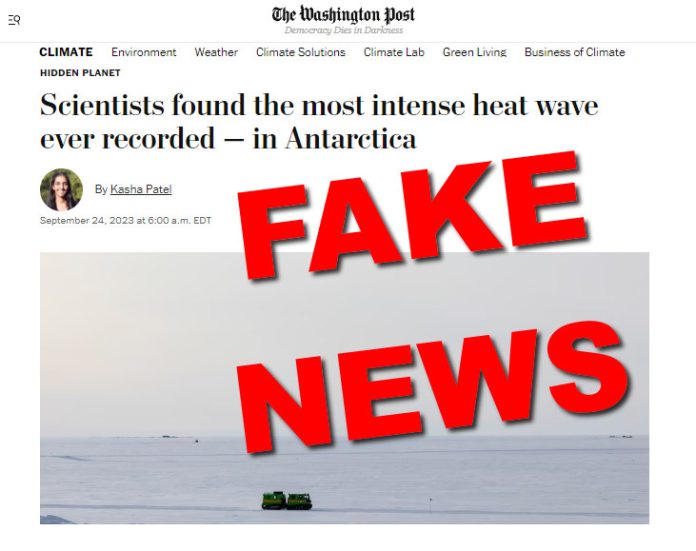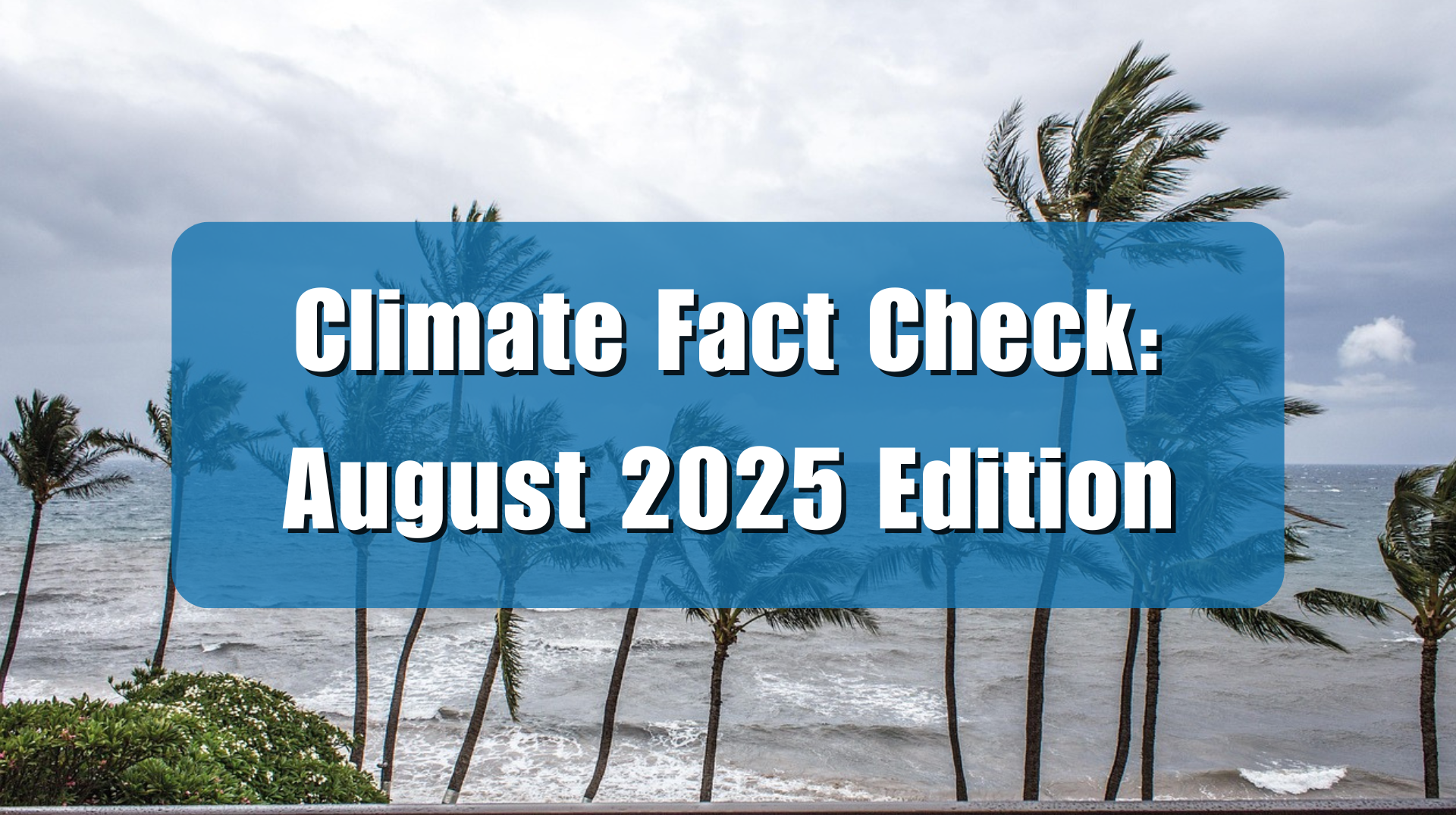On September 24th, 2023, Kasha Patel, a writer for The Washington Post (WaPo) created a story that is likely in the top 10 most false and egregious climate scare stories ever published. Titled, “Scientists found the most intense heat wave ever recorded — in Antarctica,” the story isn’t just false, it is doubly so because the research paper it is based on is also seriously flawed. In this case, peer review at Geophysical Research Letters (GRL) failed to catch and correct the most basic abuse of the definition of a “heat wave.”
The leading paragraph of the WaPo story said:
In March 2022, temperatures near the eastern coast of Antarctica spiked 70 degrees Fahrenheit (39 degrees Celsius) above normal — making it the most intense recorded heat wave to occur anywhere on Earth, according to a recent study. At the time, researchers on-site were wearing shorts and some even removed their shirts to bask in the (relative) warmth. Scientists elsewhere said such a high in that region of the world was unthinkable.
WaPo also provided a normal temperature, for reference with some “unbelievability” from the lead author of the paper.
Temperatures in March, marking a change into autumn on the continent, are typically around minus -54 degrees Celsius on the east coast near the Dome C. On March 18, 2022, temperatures peaked to minus -10 degrees Celsius. That’s warmer than even the hottest temperature recorded during the summer months in that region — “that in itself is pretty unbelievable,” said Blanchard-Wrigglesworth, an atmospheric scientist at the University of Washington.
First, it is important to point out that the so-called “heat wave” really wasn’t warm at all; the shorts and shirt removal was completely for show, rather than science. Since most people in the United States use the Fahrenheit temperature scale, which isn’t mentioned at all in the WaPo article citing the actual high temperature recorded, it was easy for reporter Kasha Patel to sneak by the idea that it was actually warm at the time.
-10 Celsius is actually 14 degrees Fahrenheit – which isn’t warm, much less a “heat wave” by any definition. Patel can’t be forgiven for not mentioning this in the article because anyone can get the conversion simply by typing it into Google, like this example.
But that isn’t the worst journalistic violation Patel makes. She mentions “70 degrees Fahrenheit (39 degrees Celsius) above normal” in the first paragraph, but neglects to offer the same reference when it comes to the actual temperature “minus -10 degrees Celsius,” clearly to hide the fact that at 14°F, it is still well below freezing (32°F) and not warm at all.
The author of the paper also makes a false claim in the GRL paper right in the title: “The Largest Ever Recorded Heatwave—Characteristics and Attribution of the Antarctic Heatwave of March 2022.”
By several meteorological definitions, the Antarctic temperature event doesn’t qualify as a heat wave at all. For example, the National Oceanic and Atmospheric Administration in their website “SciJinks” for kids defines it as:
A heat wave is a period of unusually hot weather that typically lasts two or more days. To be considered a heat wave, the temperatures have to be outside the historical averages for a given area.
At -10 Celsius/14 degrees Fahrenheit in Antarctica, “hot” is not even close. Even kids will understand this.
On an academic level, a peer reviewed paper “On the Definition of a Heat Wave” published in the Bulletin of the American Meteorological Society, clearly defines what a heat wave actually is, in table 7:

As you can see, at 14°F, Antarctica’s March weather event wasn’t even close.
And finally, the World Meteorological Organization (WMO) defines a heat wave as:
“…a period during which the daily maximum temperature exceeds for more than five consecutive days the maximum normal temperature by 9 degrees Fahrenheit (5 degrees Celsius).”
In the case of the March Antarctic temperature event, according to the GRL paper abstract, it only lasted 4 days, and so failed that test too. Clearly, despite GRL and WaPo wanting to call it a “heat wave,” by three different definitions, it was not, and the paper author and the WaPo reporter abused the definition.
Finally, there’s this in the GRL paper: “We find that the heatwave was made 2°C warmer by climate change, and future end of century heatwaves to be 5–6°C warmer, suggesting the possibility of near-melting temperatures over the East Antarctic ice cap during extreme heatwaves.”
But the WaPo reporter, who failed to catch that this wasn’t a heat wave at all, reported properly:
The complete role of climate change is still under investigation, although the new study asserts that the warmer atmosphere didn’t play a large role boosting temperatures. The team ran a suite of computer models running scenarios that included increased greenhouse gas emissions vs. a world that did not. They found climate change only increased the heat wave by 2 degrees Celsius.
At -8°C (17.6°F) versus -10°C (14°F), there’s still no significant effect. Antarctic ice didn’t melt, and there was no “shirtless” weather even though it was hyped in the article. It was all for show, roping in low-information readers who wouldn’t question “science” and the journalistic skills of WaPo.
Of course, the damage is in the headline, which most people read without reading such explanations further down in the article, much less in the scientific literature itself. Readers come away with the false impression that Antarctica has a heat wave like what they might experience in the summer where they live, and that’s the biggest lie of all.
Shame on WaPo’s Kasha Patel for not catching and correcting this, and double shame on the editors of GRL for not catching and correcting the false claim of a heat wave in the paper before they published it. We deserve better than this sort of half-baked science and reporting.






















What a farce to say it’s a heat wave when it was just not as freezing cold! Totally slanted article but like you said for the low or no information reader it was just what the author intended to occur! Another false claim!